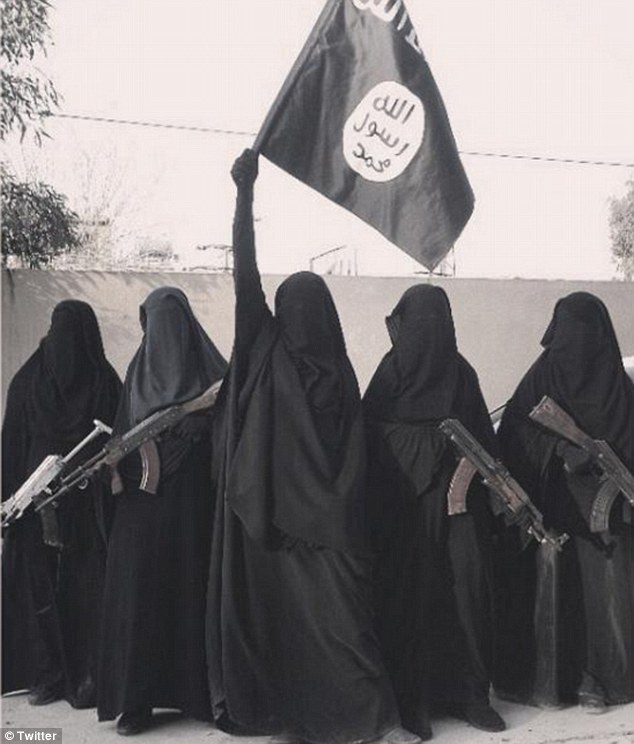Every now and then the stories of female members of the ISIS terrorist group and of other extremist organizations emerge.
The latest of these stories is that of a 16-year old German ISIS member, who was persuaded to join the group by another member through the internet. She traveled to Turkey and later to Syria where she met with her new husband, “Abou Mohammed,” whom she had never met before. He was killed on the battlefield however soon after she married him,. The German ISIS member now finds herself on trial in Iraq.
Another example is the so-called “White Widow,” former British rapper Sally Jones, who joined ISIS and was killed in a US drone strike on the Syrian-Iraqi border in June. There are several other stories of women, who have joined extremist groups such as the Muslim Brotherhood, al-Qaeda and Ansar al-Sharia.
These stories, and many others, prompted Tunisians Dr. Amal Qourami and Monia al-Arfawi to write a book, “Women and Terrorism: A Gender Study.” Published by the Masciliana publishing house in Tunisia, the seven-chapter, over 500-page book covers a range of issues, such as terrorism and gender, jihad and gender, the role of women and girls in terrorist groups, the role of families in terrorism and terrorism and identity.
In explaining her reason for writing the book, Qourami explained that there are few studies that address the role of women in terrorist and extremist groups. The fact is that the participation of women and girls in such organizations is a truth that cannot be denied. Has this issue been avoided because people have been in denial? Or is it due to male-dominated societies?
This masculine perspective and blindness to gender roles was a motivation to dedicate a study on the relationship between girls and women with terrorism, she explained.
The book particularly focuses on Moroccan and Tunisian female members of terrorist groups.
Qourami believes that female members of terror groups has not yet become a phenomenon despite the large number of such recruits and the likelihood that it will rise.
The authors asked what pushes girls and women from all over the world to join extremist groups, especially ISIS. They wondered how they are willing to sacrifice everything for the sake of jihad that contradicts, according to modern concepts, with women’s rights, seeing as organizations like ISIS advocate the establishment of patriarchal states that do not believe in equality and liberties.
Are they attracted by the idea of ISIS being able to accomplish all that it promised in establishing an Islamic “caliphate”?
The authors pose questions on why women would want to take part in terrorist activities that throughout history have been dominated by men. To answer this, they had to examine the rhetoric the terrorists used to lure the women. They also had to examine what role these women seek to play in these organizations.
Women and the dream of a male society
One of the ironies the book reveals is how Tunisian women are leading the list of female terrorists in Syria at a time when they rank the best among Arab women when it comes to enjoying their rights in Tunisia. This “mystery” has aroused anger, disappointment, and condemnation, and yet it has also sparked curiosity.
Categories of women in the terrorist organization
Arfawi said that women in the Ansar al-Sharia group are divided into three categories:
The first are wives who have been forced to submit to their husbands, who are leaders of the organization.
The second are those who have voluntarily joined the group because they believe in its ideology.
The third are sympathizers of the organization and its ideology.
The majority of the Ansar al-Sharia female members sampled by Qourami and Arfawi were between the age of 16 and 35. They noted that 90 percent of them either sympathized with the terrorists or were blackmailed into joining them. Arfawi noted that many of them were also victims of the wave of religious fervor that pervaded Tunisia in 2011 and 2012. Many women who were suffering from an identity crisis or who were initially not very religious fell victim to this wave.
Furthermore, she said that the poor and illiterates did not make up the majority of the female terrorists, but many of them were educated and came from a range of economic classes. Most of the terrorist operations were carried out by educated women.
ISIS female members vs. Qaeda counterparts
The position a female occupies in ISIS differs than the one she may occupy in al-Qaeda. Hundreds of women have joined ISIS and they formed female brigades. International reports estimate their members at 1,000, most of them foreign. They gave the likes of al-Khansa brigade, one of the fiercest ISIS units, said Arfawi. She also gave the example of the “Umm Mohammed” brigade that was led by Pakistani Aqsa Mohammed, the “Umm Moqdad” group that was led by a Saudi Arabian woman and the “Umm al-Rayyan” brigade led by a Tunisian. The majority of these female leaders married ISIS military commanders.
ISIS has proven to be a bigger draw to women than al-Qaeda because it promises them with the establishment of stability and the virtuous city. Al-Qaeda, on the other hand, did not focus on the idea of the establishment of the state.








































admin in: How the Muslim Brotherhood betrayed Saudi Arabia?
Great article with insight ...
https://www.viagrapascherfr.com/achat-sildenafil-pfizer-tarif/ in: Cross-region cooperation between anti-terrorism agencies needed
Hello there, just became aware of your blog through Google, and found ...